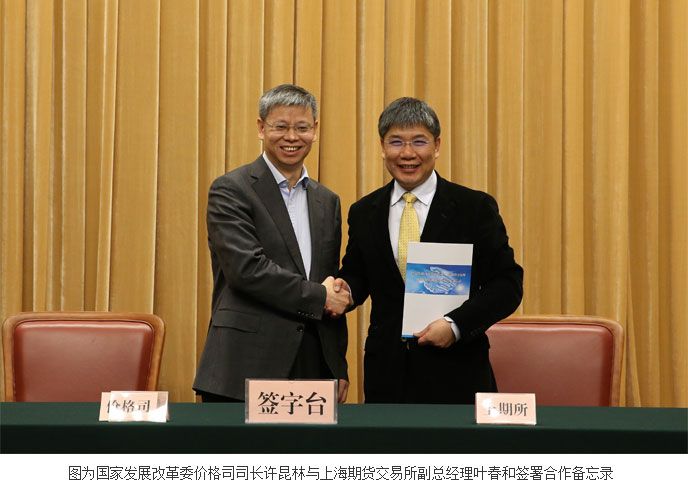Captions: Mr. Xu Kunlin, the Director General of Department of Price, NRDC, shakes hands with Mr. Ye Chunhe, the Vice General Manger of SHFE, at the signing ceremony
On March 13th, 2015, the Department of Price under NRDC, Shanghai Futures Exchange, Zhengzhou Commodity Exchange and Dalian Commodity Exchange signed a Memorandum of Understanding to improve the information sharing among involved parties, make better use of the advantages of each other, follow the latest changes in the prices of commodities, and responsively make researches to provide decision makers with policy recommendations in respect to market regulation and supervision.
Mr. Ye Chunhe, the Member of CPC Committee and Vice General manager of SHFE, delivered a speech on behalf of the three Exchanges. The key messages of the speech are shown as follows:
Honorable leaders, ladies and gentlemen:
It’s a great honor to be here today and attend the signing ceremony of the Memorandum of Understanding!
Price is one of the most important leverages available to allocate social resources and has been playing a very important role in our socialist market economy system. The open, transparent, efficient and market-based pricing model of futures market provide all market participants with a reliable price reference system. In 1995, the ex State Planning Commission and ex China National Nonferrous Metals Industry Corporation issued an official document, stipulating the average prices of the copper and aluminum futures on the ex Shanghai Metals Exchange of first business week of the document issuing month as the benchmark price of the state purchasing contracts of the same month. Since then, China has been following the pricing model that takes the commodity prices on the futures market as the benchmark prices of copper and aluminum on the spot market.
Finding price is one of the essential functions of a futures market. To make the futures prices the benchmark prices of commodities, there are a number of criteria to meet, e.g. well-matured spot markets, smooth linking of forward markets, highly efficient futures markets, etc. Without meeting these conditions, it’d be impossible for anyone to establish an effective commodity pricing system based on the futures prices and complemented with spot prices and forward prices. In a modern economic society, the futures prices have been attentively watched and widely used and spread by governments, enterprises and media. In recent years, as the power of Chinese commodity and futures markets grows, more and more businesses in the world have began to take Chinese futures prices into consideration when developing their trade contracts. For example, currently over 80% of nonferrous spot transactions in China is priced and settled in accordance with the nonferrous futures prices on the Shanghai Futures Exchange.
The speech-power over the price of commodities is relevant to the essential interest of a country. Currently, all the prices of the most important commodities like agriculture products, nonferrous metals and crude oil in global trade are determined on a few global futures markets. As the second largest economy in the world, China needs to accelerate its steps in further opening to the outside world and improve the speech-power of its commodity and futures markets in the global trade. China needs a speech-power over the pricing of bulk commodities that is in agreement with its economic development level and the weight of Chinese Factors in global real economy to secure an advantageous position in sharing the interest in global economic and trade development and assist China in the process of growing from a big economy to a powerful economy.
After over 2 decades’ exploration and development, Chinese futures markets have already achieved a lot in terms of market scale, product innovation, regulation and system development, and have closely tied up with Chinese economic development and the cause of Chinese financial reform. Currently, 46 futures products, involving agricultural, nonferrous metals, black metals, precious metals, energy, chemical and financial products, have already been listed on Chinese futures markets. In 2014, based on bilateral statistic data, the commodity futures contracts traded on Chinese futures market had already reached 4.58 billion lots, with a turnover as high as RMB 256 trillion, and key indicators like transaction volume, transaction value, client trading margins, and clients accounts, grown tens of times from the levels of 10 years ago.
It is expected that this Memorandum of Understanding signed today by the three domestic commodity and futures exchanges and the Department of Price of NDRC shall further improve the cooperation between both parties in terms of bulk commodity pricing in line with the strategies of making powerful allies and offering complementary supports. It’s our most sincere belief that this cooperation shall lead us to very rewarding results.
Thank you!
 Products Specs
Products Specs
 Trading Calender
Trading Calender
 Fees
Fees
 Rules
Rules
 Education
Education
 Back to Top
Back to Top
